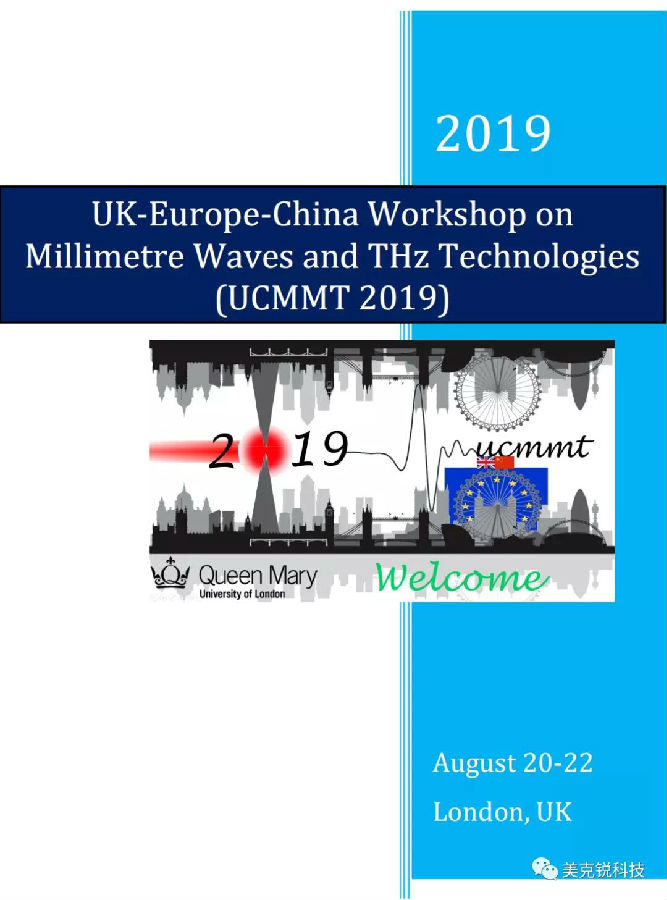
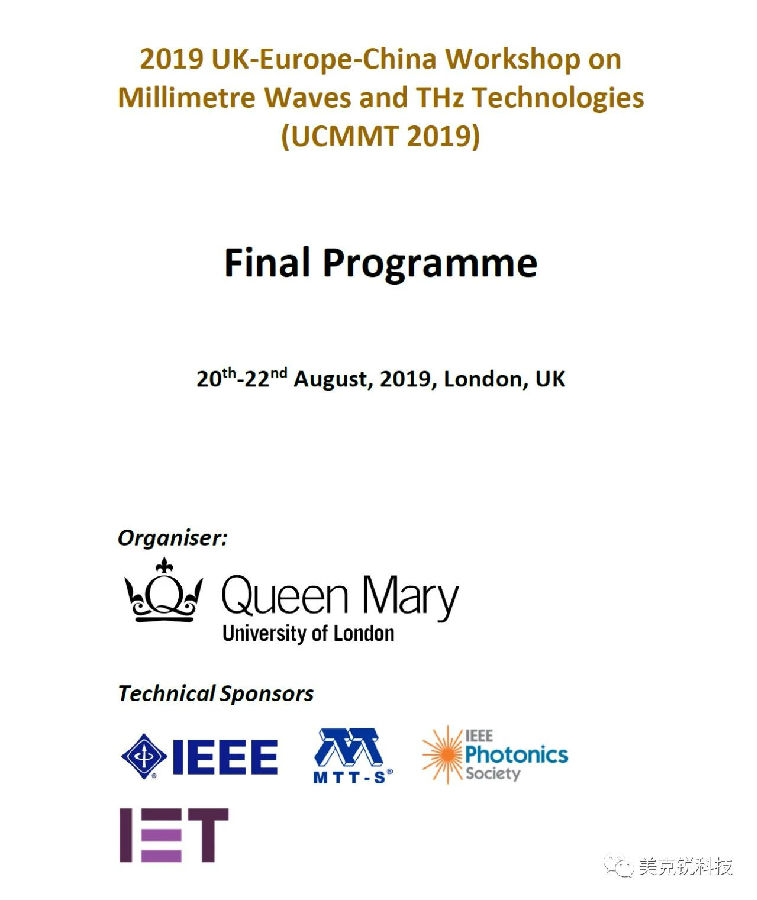
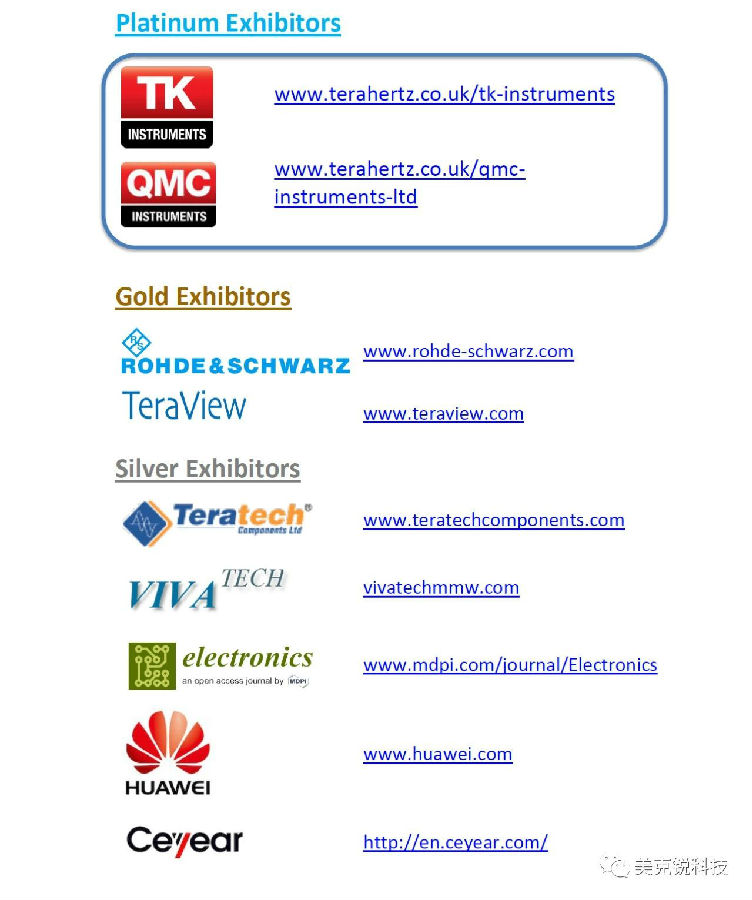
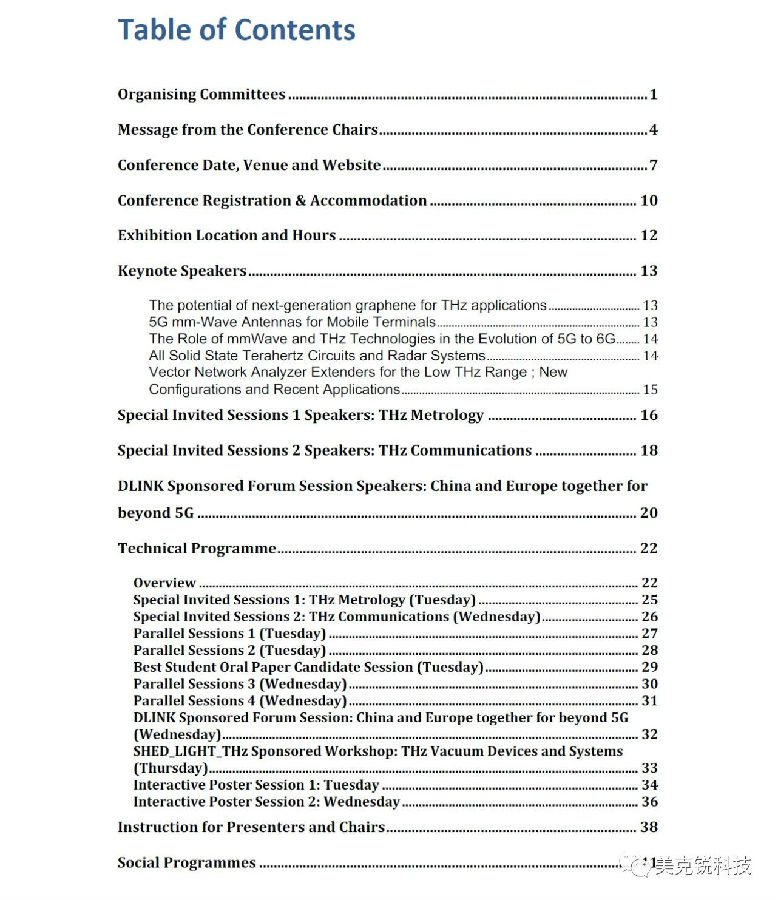
Organising Committees
General Chair
Prof Xiaodong Chen (UK)
General Co-Chairs
Prof Giorgio Savini (UK)
Prof Adrian Cross (UK)
Conference Honorary Chair
Prof Shenggang Liu (China)
Technical Programme Committee Chairs
Dr Robert Donnan (UK)
Prof Yujian Cheng (China)
International Advisory Chairs
Prof Alan Phelps (UK)
Prof Yang Hao (UK)
Prof Clive G. Parini (UK)
Finance Chair
Dr Yasir Alfadhl
Publicity/Publication Chair
Akram Alomainy
Local Organisation Chair
Dr Yue Gao (UK)
Social Events Chair
Lucy Wylde
International Advisory Committee
Matt Griffin, Cardiff University, UK
Byron Alderman, Rutherford Appleton Laboratory, UK
Xuyuan Chen, Vestfold University College, Norway
Xiaolong Dong, National Space Science Center, Chinese Academy of Sciences, China
Yong Fan, UESTC, China
Guangyou Fang, Insititute of Electrics, Chinese Academy of Sciences, China
Yubing Gong, UESTC, China
Yi Huang, University of Liverpool, UK
Wei Hong, Southeast University, China
Peter de Maagt, European Space Agency, The Netherlands
Jian-Rong Gao, SRON Netherlands Institute for Space Research, The Netherlands
Ming Pan, CETC-50, China
Chunting Wang, CETC-54, China
Jian Wu, CETC-22, China
Claudio Paoloni, Lancaster University, UK
Peter Hargrave, Cardiff University, UK
Stafford Withington, University of Cambridge, UK
Dehua Li, Shandong University of Science and Technology, China
Shengcai Shi, Purple Mountain Observatory, Chinese Academy of Sciences, China
Caidong Xiong, UESTC, China
Xiaobo Yang, UESTC, China
Rui You, China Academy of Space Technology, China
Guozhong Zhao, Capital Normal University, China
Ghassan Yassin, University of Oxford, UK
Peter Jepsen, Technical University of Denmark
Lingling Sun, Hangzhou Dianzi University, China
Kaixue Ma, Tianjin University, China
Technical Programme Committee
Stepan Lucyszyn, Imperial College London, UK
Peter Hargrave, Cardiff University, UK
Axel Zeitler, University of Cambridge, UK
Brian Ellison, STFC Rutherford Appleton Laboratory, UK
Nick Ridler, National Physical Laboratory, UK
Huifeng Ma, Southeast University, China
Claudio Paoloni, Lancaster University, UK
Yue Li, Tsinghua University, China
Yi Huang, University of Liverpool, UK
Jiafeng Zhou, University of Liverpool, UK
Yaochun Shen, University of Liverpool, UK
Yi Wang, University of Birmingham, UK
Stephen Hanham, University of Birmingham, UK
Vasilis Apostolopoulos, University of Southampton, UK
Yue Gao, Queen Mary University of London, UK
Oleks Sushko, Igor Sikorsky Kyiv Polytechnic Institute, Ukraine
Sillas Hadjiloucas, University of Reading, UK
Ming-Chun Tang, Chongqing University, China
Kai Kang, University of Electronic Science and Technology of China, China
Sanming Hu, Southeast University, China
Lei Zhao, Jiangsu Normal University, China
Yasir Alfadhl, Queen Mary University of London, UK
Wenlong He, University of Strathclyde, UK
Xiu Yin Zhang, South China University of Technology, China
Ying Liu, Xidian University, China
Yuan Yao, Beijing University of Posts and Telecommunications, China
Guo Qing, Hangzhou Dianzi University, China
Zhixiang Huang, Anhui University, China
Alexander Valavanis, University of Leeds, UK
Jixin Chen, Southeast University, China
Zhihao Jiang, Southeast University, China
Qingfeng Zhang, Southern University of Science and Technology, China
Yikai Chen, University of Electronic Science and Technology of China, China
Michael Lancaster, University of Birmingham, UK
Bo Zhang, University of Electronic Science and Technology of China, China
Xian Qi Lin, University of Electronic Science and Technology of China, China
Dazhi Ding, Nanjing University of Science and Technology, China
Akram Alomainy, Queen Mary University of London, UK
Bin Yang, University of Chester, UK
Maged Elkashlan, Queen Mary University of London, UK
James Kelly, Queen Mary University of London, UK
Local Organisation Team (all from Queen Mary University of London)
Ardavan Rahimian
Jin Zhang
Chao Shu
Shaoqing Hu
Tianzhong Zhang
Yihua Zhou
Yujie Liu
Zia Ullah Khan
Message from the Conference Chairs
We would like to welcome all of you to the 12th UK/Europe-China Workshop on
Millimetre-Waves and Terahertz Technologies (UCMMT) 2019, Queen Mary
University of London, London, UK.
UCMMT was born by the microwave, millimetre wave and THz communities in
UK/Europe and China 12 years ago meeting to share and present research knowledge
and ideas. Since the first UCMMT meeting held in Chengdu in 2008 the conference
has convened every year, hosted in alternate years in UK/Europe and China.
UCMMT provides a forum for presentation and discussion of topics on vacuum
devices, vacuum micro-electronics and their applications, the theory and
technological developments of vacuum electron devices, antennae and THz
sourcesdetectors as well as THz materials and measurement apparatus. This year, we
have organised two special sessions one on THz Metrology and the other on THz
communications. UCMMT 2019 starts with a welcome session and the first Keynote
presentation on Tuesday morning, August 20th. The opening keynote session includes
presentations by Professor Sir Colin Humphreys on “The potential of next-generation
graphene for THz applications” and Dr. Hanyang Wang on “5G mm-Wave Antennas
for Mobile Terminals”.
The first poster session including the best student poster presentations is after lunch
on the Tuesday followed by two parallel sessions and the best student oral
presentations. On the evening of the same day we will have a banquet at the end of
which the UCMMT Best Student Paper Awards will be given. We thank the 10
sponsors and exhibitors for their support and the IEEE, MTT Society, Photonic
Society and IET for their technical sponsorship
On Wednesday morning, 21st of August there will be 3 keynote presentations by:
Professor Wei Hong on “the Role of mmWave and THz Technologies in the
Evolution of 5G to 6G”; Prof Yong Fan on “all Solid State Terahertz Circuits and
Radar Systems”; and Mr. David R. Vizard on “Vector Network Analyzer Extenders
for the Low THz Range; New Configurations and Recent Applications” . Two parallel
oral sessions will take place on the Wednesday afternoon followed by a DLINK
sponsored forum on China and Europe together and beyond 5G activity. On the
Thursday morning there will be SHED_LIGHT_THz sponsored workshop on THz
Vacuum Devices and Systems.
It is our desire that all of you enjoy not only the technical aspects (papers, posters and
exhibits) of the conference but also the friendship of colleagues and the social and
cultural events that have been organised. These include a performance of Romeo and
Juliet at Sadler's Wells Theatre on the Wednesday evening and the Thames River
Cruise and visit to Greenwich Observatory Museum on Thursday the 22nd of August.
We hope everyone will take away fond memories of the 12th UCMMT 2019 in London.
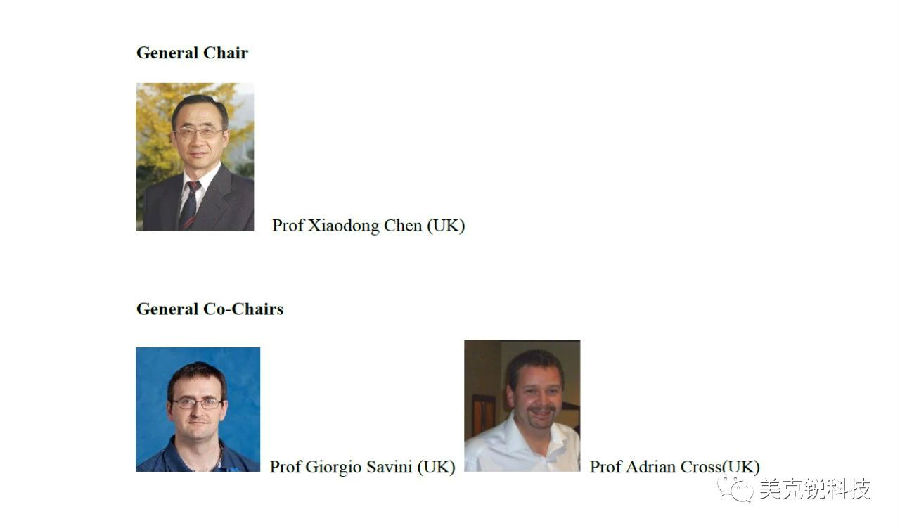
Message from the Conference TPC Chairs
On behalf of the Technical Programme Committee (TPC), we are very pleased to welcome you to London for the 12th UK-Europe-China Workshop on Millimetre Waves and THz Technologies (UCMMT 2019).
We have received over 86 papers from the UK, Europe and China. All submitted papers were reviewed by members of the TPC and on their recommendations a total number of 71 papers were accepted for presentation at UCMMT 2019.
To celebrate the 12th anniversary, we have invited five (very top) keynote speakers from the UK, Europe and China and have also organised Special Sessions on THzMetrology and THz Communications. We have organised a panel session on China and Europe together and beyond 5G activity and arranged 4 oral sessions and two poster sessions. As a tradition of UCMMT conferences, 10 student papers were shortlisted
to take part in the best student paper contest, 5 being presented in an oral session while 5 being presented in a poster session.
We look forward to seeing you in London in August 2019.
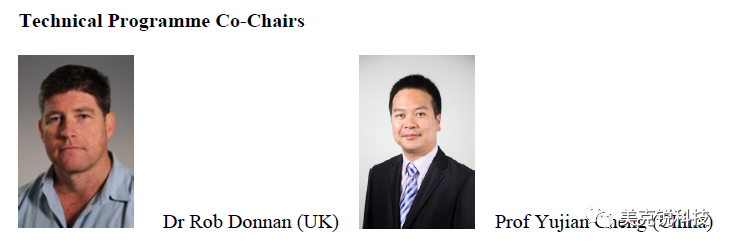
Conference Date, Venue and Website
Conference Website:
http://www.ucmmt2019.com/ where you can find most information you need. Free internet access will be provided at the conference.
Conference Date:
20-22 August, 2019
Conference Venue:
Graduate Centre,
Queen Mary University of London, Mile End Rd
London
E1 4NS
United Kingdom
+44 (0)20 7882 5555
https://www.qmul.ac.uk/investing-campus/graduate-centre/
With a location which puts you within easy reach of London’s business district, shopping thoroughfares and major tourist attractions, Queen Mary University of London is surrounded by high end to budget hotels, which present ideal choices for guests looking for comfort, convenience and welcoming service.

The Graduate Centre is a state-of-the-art Eco-friendly new building housing multiple graduate institutes and services along with well-planned and structured auditorium and multiple lecture rooms and facilities.
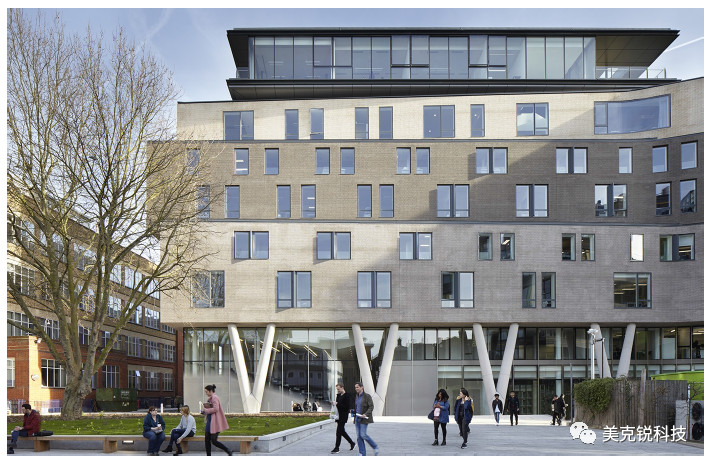
The Graduate Centre is a 6-minute walk away from Stepney Green Station (the nearest underground station), or a 10-minute walk away from Mile End Station. You can get there by District/Hammersmith & City/Central line.
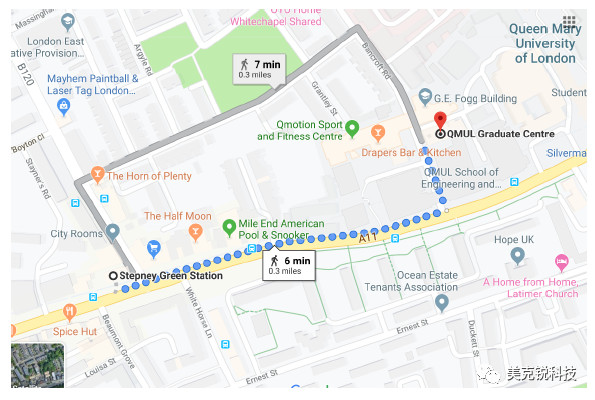
Our main conference room is GC G10 Peston Lecture Theatre on the ground floor, for Opening session/2 Keynote sessions/2 Special invited sessions/Student oral session/Forum Session/Vacuum Electronics Workshop and parallel session 1/3.
Additionally, we have booked GC 101 on the first floor for parallel session 2/4, and GC114 & GC105 for all poster sessions.
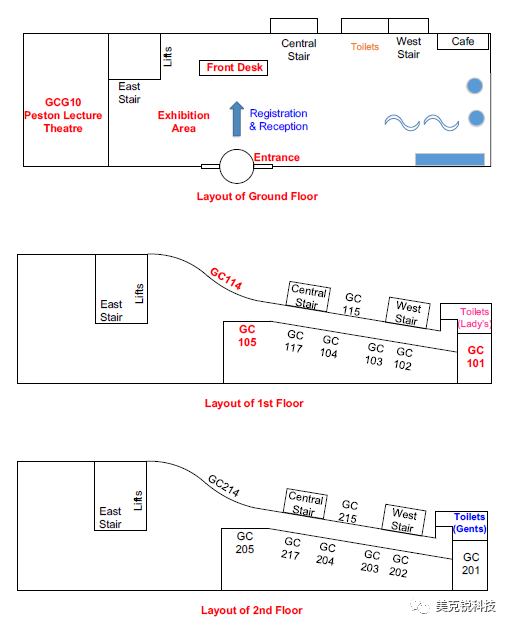
Conference Registration & Accommodation
Conference Registration & Reception:
Please register online. Onsite registration desk only hands out the pre-registered packages, available at the foyer on the ground floor of the Graduate Centre during the hours shown below:
Monday, 19 August: 14:30 to 18:00
Tuesday, 20 August: 8:00 to 9:00
Wednesday, 21 August: 8:00 to 9:00
The conference fees for UCMMT2019 are as follows. Conference dinner, lunch and refreshments are inclusive for most of registration packages, except for the students not shortlisted for best paper contest, who needs to pay additional £50 (Guest Registration) to attend the conference dinner and social events. A hardcopy of the invoice/receiptwill be provided for all delegates. Please ask the registration desk if necessary.
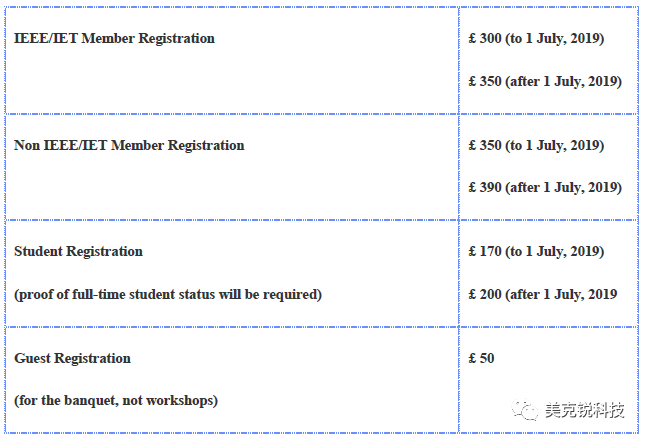
Lunches will be served at the Curve. Tea/coffee breaks will be served on the ground floor of the Graduate Centre for all registered delegates. Conference dinner on Tuesday, 20 August will be served at Octagon, and the dinner on Wednesday, 21 August will be served with food bags before departure to the theatre.
Accommodation:
We have set up an allocation of 40 single ensuite bedrooms on the campus on the 19,20, 21, 22 and 23 August 2019 which delegates can book via our website https://book.qmaccommodation.co.uk/, with the promotional code: UCMMT2019, and the rate is £49.00 per room per night including breakfast and VAT.
In addition to accommodation at the conference venue, the East of London is popular with business and tourist hotels with high standards in services and amenities. Please click on the map below to check alternative accommodation options close to the venue by choosing your arrival and check-out dates.
Hotels near Queen Mary University of London on Booking.com (19th - 24th AUG)
Please visit our conference website for more details.
Exhibition Location and Hours
All exhibitors will be in the Graduate Centre during the hours shown below:
Tuesday, 20 August: 9:00 to 18:00
Wednesday, 21 August: 9:00 to 18:00
Platinum Exhibitors
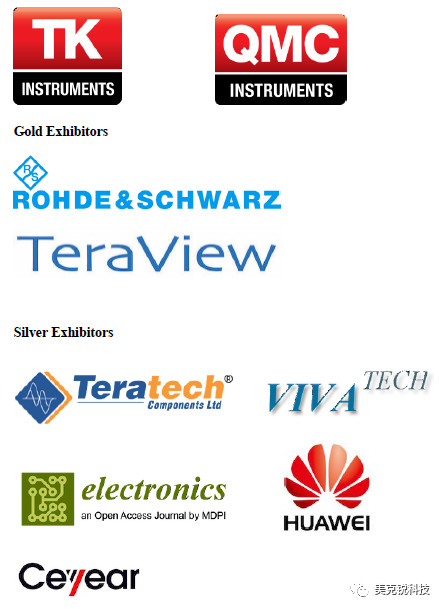
Keynote Speakers
The potential of next-generation graphene for THz applications Professor Sir Colin Humphreys, Queen Mary University of London, UK

Colin Humphreys is Professor of Materials Science and Director of Research in the Department of Materials Science andMetallurgy, University of Cambridge and a Fellow of SelwynCollege, Cambridge. He is a Fellow of the Royal Society and a Fellow of the Royal Academy of Engineering. He was educated atImperial College (BSc) and Cambridge (PhD). He was a Lecturer at Oxford and a Professor in Liverpool before coming toCambridge. He founded and directs the Cambridge Centre for Gallium Nitride (GaN). He founded a spin-off company, CamGaN, to exploit the research of his group on low-cost LEDsfor home and office lighting. The company was acquired in February 2012 by Plessey, which is now manufacturing LEDs based on this technology at their factory in Plymouth, UK. He founded and directs the Cambridge/Rolls-Royce Centre for Advanced Materials for
Aerospace. Materials developed by this Centre are now flying in Rolls-Royce engines. He has given public lectures on science throughout the world. He has received national and international medals for his research in electron diffraction and microscopy and in GaN. He is also the author of The Miracles of Exodus and The Mystery of the Last upper:
Reconstructing the Final Days of Jesus. He was Knighted in 2010 for services to science.
5G mm-Wave Antennas for Mobile Terminals
Dr. Hanyang Wang, Huawei Fellow, Chief Terminal Antenna Expert, HUAWEI Technologies

Hanyang Wang received the Ph.D. degree from Heriot-Watt University, Edinburgh, U.K. in 1995. From 1986 to 1991, he served as a Lecturerand an Associate Professor with Shandong University, Jinan, China.From 1995 to 1999, he was a Post-Doctoral Research Fellow with the University of Birmingham, Birmingham, U.K., and the University of Essex, Colchester, U.K. From 1999 to 2000, he was with Vector FieldsLtd., Oxford, U.K., as a Software Development and MicrowaveEngineering Consultant Engineer. He joined Nokia U.K. Ltd.,Farnborough, U.K. in 2001, where he had been a Mobile Antenna
Specialist for 11 years. He joined Huawei Technologies after leaving Nokia, and he is currently the Chief Mobile Antenna Expert and the Head of the Mobile Antenna Technology Division. He is also an Adjunct Professor with the School of Electronics and Information Technology,Sichuan University, Chengdu, China. His current research interests include small and multiband antennas for mobile terminals, antennas and antenna arrays for 5G mobile communications, and numerical methods for the solutions of electromagnetic radiation and
scattering problems. He holds over 50 granted and pending US/EU/CN patents, and he has authored over 100 refereed papers on these topics. He was a recipient of the Title of Nokia Inventor of the Year in 2005 and the Nokia Excellence Award in 2011. He was also a recipientof the Huawei Individual Gold Medal Award in 2012 and the Huawei Team Gold Medal Award in 2013 and 2014, respectively. His patent was ranked number one among 2015 Huawei top ten patent awards. Dr. Wang is a Huawei Fellow and an IET Fellow. He is an ssociate Editor ofthe IEEE Antennas and Wireless Propagation Letters.
The Role of mmWave and THz Technologies in the Evolution of 5G to 6G
Professor Wei Hong, Southeast University, China

Wei Hong (M’92-SM’07-F’12) received the B.S. degree from the
University of Information Engineering, Zhengzhou, China, in 1982, and
the M.S. and Ph.D. degrees from Southeast University, Nanjing, China,
in 1985 and 1988, respectively, all in radio engineering.
Since 1988, he has been with the State Key Laboratory of Millimetre Waves and serves for the director of the lab since 2003, and is currently a professor and the dean of the School of Information Science and Engineering, Southeast University. In 1993, 1995, 1996, 1997 and
1998, he was a short-term Visiting Scholar with the University of California at Berkeley and at Santa Cruz, respectively. He has been engaged in numerical methods for electromagnetic problems, millimetre wave theory and technology, antennas, RF technology for wireless
communications etc. He has authored and co-authored over 300 technical publications withover 9000 citations, and authored two books. He twice awarded the China State Natural Science Prizes (second and fourth classes), thrice awarded the first-class Science and Technology
Progress Prizes issued by the Ministry of Education of China and Jiangsu Province Government etc. Besides, he also received the Foundations for China Distinguished Young Investigators and for “Innovation Group” issued by NSF of China.
Dr Hong is a Fellow of IEEE, Fellow of CIE, Vice-Presidents of Microwave Society and Antenna Society of CIE, Chairperson of IEEE MTT-S/AP-S/EMC-S Joint Nanjing Chapter. Besides, he was an IEEE MTT-S AdCom Member (2014-2016), and served for the associate
editor of IEEE Trans. on MTT during 2007-2010.
All Solid State Terahertz Circuits and Radar Systems Professor Yong Fan, University of Electronic Science and Technology of China, China

Yong Fan, Professor, University of Electronic Science and Technology
of China(UESTC), Dean of School of Electronic Engineering, was born
in 1963. He received the B.E. degree from Nanjing University of cience and Technology, Nanjing, Jiangsu, China, in 1985, and theM.S. degree from University of Electronic Science and Technology of China Chengdu, Sichuan China,in 1992.
Prof. Fan is an IEEE senior member, a senior member of Chinese
Institute of Electronics. From 1985 to 1989, he was interested in microwave integrated circuits.
Since 1989, He dedicated himself to researching and teaching on subjects of Electromagnetic Fields and Microwave Techniques for many years. His main research fields are as follows: electromagnetic theory, millimeter-wave communication, millimeter-wave and erahertzCircuits etc. Besides, he was interested in other subjects including Broadband Wireless Access, automobile anti-collision , intelligent transportation intelligent transportation etc. He hasauthored and co-authored over 300 papers in various and famous technical journals at home and abroad, such as IEEE Trans. MTT, Microwave and Optical Technology Letters, IEE Electronics Letters, International Journal of Electronics etc. More than 80 papers have beenembodied by SCI.
Vector Network Analyzer Extenders for the Low THz Range ; New
Configurations and Recent Applications Mr. David R. Vizard, Co-founder of VivaTech SARL France

David R. Vizard (Date of Birth: March 10th 1950, Belfast, United Kingdom) obtained a BSc degree in electronics from the University of
Manchester Institute of Science and Technology (UMIST) UK in 1971
and first worked for Marconi Communication Systems, UK designing
high linearity receiver front-ends. In 1972 he joined the Radio esearch Station, Slough, UK, where he developed millimeter-wave solarastronomy and low noise cryogenic receiver technologies for astronomy and space-borne applications. At age 28 he was promoted to the rank of Senior Scientist, the youngest ever to reach this position within the UK Scientific Civil Service, and then relocated to the newly formedRutherford Appleton Laboratory.
From 1978 he worked at the UK’s Science Research Council utherford Laboratories, Oxford, UK, subsequently leading the Millimetre Wave Technology Division, which provides radio astronomical and atmospheric science spaceflight hardware in support of a number of spaceprograms. These included the UK’s Meterological Satellite AMSU-B at 89-183 GHz and a first prototype of ESA’s MeteoSat covering 20-200 GHz. During 1982- 86, when seconded to NASA-JPL, SA, he designed, developed and completed the successful integration of the world’s first space-borne 183 GHz radiometer launched by the Space Shuttle as part of the Upper Atmosphere Research Satellite (UARS) payload.
From 1986, he took on the role of Technical Manager at Farran echnology Ltd, an emerging Irish mm-wave start-up company. Later, becoming a founding Director he was instrumental in the growth of the company’s turnover from less than 400 K Euro p.a. to a peak of 3.5 M Euro. During this time, he directed Farran’s product development in numerous areas including passive imaging, space flight radiometers, millimeter-wave frequency extenders, and Enhanced Flight Vision System (EVS) radars using FMCW technologies. Farran developed a number ofleading edge mm-wave products including imaging systems and was purchased by Smiths Detection (USA) in February 2005.
In 2006 he co-founded VivaTech SARL France, a design and manufacturing company specializing in custom developments in the mm-wave and THz range, for a wide range of global customers. VivaTech SARL enjoys privileged R & D funding from the French Government and apart from its manufacturing activities has consulted for various top tier Companies andUniversities such as Thales Optronics S.A., Hong Kong City University amongst others.
VivaTech has a wide range of global clients in many sectors where the use of mm/THz technology is of key importance.
Special Invited Sessions 1 Speakers: THz Metrology
Title: From sensor to microcalorimeter: Traceable power measurement at terahertz frequency
Professor Dr Xiaohai Cui (National Institute of Metrology (NIM), P R China)
Biography – Xiaohai Cui received the B.S. and Ph.D. degrees in electrical engineering from the Beijing Institute of Technology, Beijing, China in 1996 and 2004, respectively.
He joined the National Institute of Metrology (NIM), P. R. China, in 2004. During 2007,2008 and 2017, he worked in the Electromagnetics Division at NIST, USA, as a guestresearcher. His primary research interest is microwave power standards and microwave power measurement. He is very active in participating and organizing international
comparisons of RF power measurements. His current research is imed at primarypower standards from 10 MHz to 330 GHz. Dr. Cui is also a professor at the Beijing
University of Posts and Telecommunications, and was a recipient of the Science andTechnology Award of the third class from the Local Beijing Government of China in 2011, the Electronic Information Science and Technology Award of the second class from the Chinese Institute of Electronics in 2012, and NIM’s Science and Technology
Award of the first class (first place) in 2014.
Title: Terahertz High-Resolution Gas-Phase Spectroscopy
Prof Brian Ellison (Rutherford Appleton Laboratory, UK)
Biography – Brian Ellison (CEng, FIET) leads the Millimetre-wave
Technology and Chilbolton Radio Observatory Group within
Rutherford Appleton Laboratory Space Department (RAL Space), UK. He began his career at Chilbolton Observatory and developed microwave instrumentation in support of radio astronomy. Moving to the California Institute of Technology, USA, he developed terahertz receivers for astrophysics research. Returning to the UK, and RAL, he continued with terahertz research and simultaneously undertook the role of UK Project Manager for the Atacama Large Millimetre/submillimetre Array (ALMA) during its construction phase. Brian is a visiting professor within The Open University Faculty of Science, Technology,
Engineering and Mathematics.
Title: Feasibility of Accurate Power Measurement in ubmillimeter/mm-Wave
Domain Based on Free-Space Techniques
Dr Alireza Kazemipour (METAS, Switzerland)
Biography – Alireza Kazemipour received the B.Sc. degree in lectronics andTelecommunications from Sharif University of Technology, the M.Sc. degree in Physics from Tehran University, Iran, and Ph.D. from Telecom-ParisTech, France, in 2002. He was an Associate Professor in Korea and Malaysia and a senior scientist with the European National Institutes of Metrology NMIs 2002-2018. He is currently with The Federal Institute of Metrology (METAS), Bern – Switzerland.
Title: Measurements of S-parameters and material properties at millimeter-wave and terahertz frequencies
Dr Xiaobang Shang (National Physical Laboratory, UK)
Biography – Xiaobang Shang was educated at the University of Birmingham, UK,where he was awarded a PhD in 2011 for research into terahertz circuits. After graduation, he worked at the University of Birmingham as a Research Fellow. Since 2017, he has been working at NPL as a Senior Research Scientist. He has published over 60 scientific papers on microwave measurements and microwave circuits. Dr Shang is a Senior Member of IEEE, and an executive committee member of the IET’sRF and Microwave Technology Technical and Professional Network (TPN). He was the recipient of the ARFTG Microwave Measurement Student Fellowship Award in 2009, and, the IEEE Tatsuo Itoh Award in 2017.
Title: The design and implementation of an integrated 110GHz vector networkanalyzer
Dr. Baoguo Yang (China Electronics Technology Group Corporation No.41 Institute, P R China)
Biography – Dr. Baoguo Yang has been engaged in the analysis and testing of microwave network parameters since 2012. He has presided over 10 national or provincial projects with a total expenditure of over 100 million yuan. He has also authorized 11 Chinese invention patents and 1 international invention patent (as First inventor), published 12 papers (including as the first author and correspondence author), and formulated 4 national standards (ranked 3rd). He is one of the Top Young Talents of the China Electronics Technology Corporation and chief engineer of the on-chip testing system.
Special Invited Sessions 2 Speakers: THz Communications
Title: Short Range Multi-Gigabit Wireless Links
Professor Edward Wasige (University of Glasgow, UK)
Biography – Edward Wasige is a Professor and leads the High Frequency Electronics Group at the University of Glasgow. He joined the University of Glasgow as a Lecturer in 2002. Before that, he was a UNESCO Postdoctoral Fellow at The Technion, Israel Institute of Technology. His current research covers gallium nitride device technologiesfor power electronics and for microwave electronics, and indium phosphide based device and integrated circuit technologies for microwave, millimetre-wave and terahertz electronics. He leads a number of projects on these topics with funding by the European Commission under the Horizon 2020 Programme and by the Engineering and Physical Sciences Research Council.
Title: GaAs Schottky Components for a 300 GHz Communication System Professor Yi Wang (University of Birmingham, UK)
Biography – Yi Wang received the B.Sc. degree in physics and M.Sc. degree in condensed matter physics from the University of Science and Technology, Beijing, China, in 1998 and 2001, respectively, and the Ph.D. degree in electronic and electrical engineering from the University of Birmingham, Edgbaston, Birmingham, U.K., in 2005. In 2011, he became a Senior Lecturer and then Reader at the University ofGreenwich. In 2018, Yi joined Birmingham as a Senior Lecturer. His current research interests include millimeter-wave and terahertz devices for metrology, communicationsand sensors, micromachining, microwave circuits based on multiport filtering networks, and filter-antenna integration.
Title: Review the Progress of Silicon Based THz
Professor Kaixue Ma (Tianjin University, China)
Biography – Kaixue Ma (M’05–SM’09) received the B.E. and M.E. degrees from Northwestern Polytechnical University, Xi’an, China, and the Ph.D. degree from Nanyang Technological University (NTU), Singapore.
From 1997 to 2002, he was with the China Academy of Space Technology, Xi’an, where he became the Leader of the Millimeter-Wave Group for space-borne microwave and millimeter-wave components and subsystems for satellite payload and very-smallaperture
terminal ground stations. From 2005 to 2007, he was the Research and Development Manager with MEDs Technologies. From 2007 to 2010, he was the Research and Development Manager, the Project Leader, and the Technique Management Committee Member with ST Electronics. From 2010 to 2013, he was a Senior Research Fellow and the Millimeter-Wave RFIC Team Leader with NTU, where he was involved in the 60-GHz Flagship Chipset Project. From 2013 to 2018, he was a Full Professor with the University of Electronic Science and Technology of China, Chengdu, China. He is currently a Professor and the Dean of the School of Microelectronics, Tianjin University, Tianjin, China. He has given invited talks and keynote addresses over 20 times. He has authored or co-authored two books and over 230 referable international journals and conference papers in the related area and filed 41 patents. His current research interests include RF/microwave/ millimeter-wave/terahertz-integrated circuits and system design using CMOS, GaAs monolithic microwave integrated circuit, MEMS, and LTCC for applications such as satellite communication and software-defined radio.
Dr. Ma received eight international technique awards including the Best Paper Award.
He is also a project PI of National Key R&D Program of China on THz. He was named in the China Thousand Young Talent Program in 2012 and The National Distinguished Young Scholar Program in 2016. He is on the Review Board for several international journals, Associate Editor, IEEE Transactions on Microwave Theory and Techniques and the Coordinator of IEEE IMS MGA R10 CN/SG Since 2018.
Title: High Speed Signal Processing for Terahertz Band ommunications
Professor Zhi Chen (UESTC, China)
Biography – Zhi Chen is currently a Professor with the National Key Lab of Science and Technology on Communications, University of Electronic Science and Technology of China (UESTC), since August 2013. He received B. Eng, M. Eng., and Ph.D. degree in Electrical Engineering from UESTC, in 1997, 2000, 2006, respectively. On April
2006, he joined the National Key Lab of Science and Technology on Communications, UESTC. He was a visiting scholar at University of California, Riverside, during 2010 - 2011. He was also a senior visiting professor at Rutgers, The State University of New Jersey, in 2016. He is the deputy director of Key Laboratory of Terahertz Technology, Ministry of Education. His current research interests include Terahertz Band Communication, 5G/B5G Mobile Communications. He is a senior member of the IEEE.
Title: THz spatial modulator based on the active 2DEG metasurface
Professor Yaxin Zhang (UESTC, China)
Biography – Dr. Yaxin Zhang received the B.Sc.degree from Sichuan University, Chengdu, China, in 2003, and the M.Sc. and Ph.D. degrees from the University of Electronic Science and Technology of China, Chengdu, in 2006 and 2009, respectively.
He is currently a Professor with the China Terahertz Science and echnology ResearchCenter, University of Electronic Science and Technology of China. His main research interests include terahertz high-speed wireless communication technology, including new terahertz signal source for wireless communication and terahertz functionaldevices (terahertz modulator, resonator, filter, etc.).
DLINK Sponsored Forum Session Speakers: China and
Europe together for beyond 5G

THz wireless communications is the emerging field for enabling 5G and beyond 5G networks. High technology challenges, high implementation costs, relatively limited knowledge of the propagation scenarios need an outstanding research effort to bring THz communication systems from laboratory to real environment.
Europe and China are at the forefront of the THz communication technology.
This panel will explore by the contribution of distinguished panellists the great opportunity of a common road map between Europe and China for a quantum leap in THz communications.
The audience will be invited to engage with the panellists proposing questions before the panel and discussing from the floor in an informal manner.
Panel Chair: Prof Claudio Paoloni
Panelist:
1. Prof. Maziar Nekovee (University of Sussex, UK)
2. Prof. Wei Hong (Southeast University, China)
3. Dr. Hairui Liu (China Institute of Information and Communication, China)
4. Dr. Haroon Khan (Huawei, Germany)
5. Mr. David Vizard (Vivatech, France)
Professor Claudio Paoloni (Lancaster University, UK)
Biography– Claudio Paoloni is Head of Engineering Department at Lancaster University and Cockcroft Chair. He is author of more than 220 articles in international journals and conference proceedings in the field of high frequency electronics, millimetre wave vacuum electron devices and novel 5G wireless network.
He is Coordinator of the Horizon 2020 project TWEETHER "Travelling wave tube based w-band wireless networks with high data rate distribution, spectrum & energy efficiency" and of the H2020 ULTRAWAVE “Ultra capacity wireless layer beyond 100 GHz based on millimeter wave Traveling Wave Tubes”.
He served as Local Organization Chair of IEEE International Vacuum Electronic Conference 2009 (IVEC 2009), as Conference Chair of UK/Europe China Millimeter Wave and THz Technology Workshop 2013 (UCMMT2013) held in Rome. He was Chair of the Technical Programme Committee of the International Vacuum Electronics
Conference 2017 (IVEC) held in London. He was Guest Editor for the Special Issue of Transaction on Electron Devices on Vacuum Electronics (June 2014).
He is Chair of the IEEE Electron Devices Society Vacuum Devices Technical Committee.
Professor Maziar Nekovee (University of Sussex, UK)
Biography – Maziar Nekovee is Professor of Telecommunications an Head of Centre for Advanced Communications, Mobile Technology and IoT at University of Sussex.
His current research focuses on 5G and beyond-5G Mobile Communications, AI for mobile networks and THz communications for 6G. Prior to his current post he was from 2013 to 2017 Head of Samsung’s UK and European Research and Collaborations in 5G . Prior to joining Samsung he was from 2001-2013 with BT Research and Innovation as a team leaders and senior scientist. Maziar has a PhD inPhysics from University of Nijmegen and a first degree in Electrical and Electronic Engineering from Delft University of Technology, both in the Netherlands. He is the author of over 100 highly cited papers, one book and 13 patents. He is Vice Chair of
NetWorld 2020 European Technology Platform, which contributes to EC’s strategic research and innovation roadmap in communication technologies and is a Steering Board Member of EPSRC-funded Comnet2.
Dr. Hairui Liu (China Institute of Information and Communication, China)
Biography– Hairui Liu, PhD, is a senior engineer of millimeter wave technology in China Institute of Information and Communication. He is the Secretary General of China Millimeter wave and Terahertz Alliance (MTA).
Dr. Liu received the degree of B.Sc. in Electronic Engineering from Beihang
University (BUAA), Beijing, China in 2006, degree of M.Sc in Microwave
Electronics from Beihang University in 2009, and the degree of Ph.D. in Physical Electronic from Beijing University of Posts and Telecommunications (BUPT),Beijing, China in 2013. From September 2010 to October 2011 he joined MMT
Group of Rutherford Appleton Laboratory (RAL), UK, as a visiting scientist. In September 2013 he was employed by Beijing University of Posts andTelecommunications (BUPT), as a Postdoc.
In December 2016 he employed by China Institute of Information and
Communication as a senior engineer. From August 2018, he was responsible for preparing the China Millimeter wave and Terahertz Alliance (MTA), and chosen to be the Secretary General when MTA was founded in April 26th 2019.
His research interests are in millimeter wave and terahertz devices, wireless communications and applications. His work is mainly on the study of industrial development in millimeter wave and terahertz, organizing alliance activities to promote exchange between industry and scientific research.
Mr. Haroon Khan (Huawei Technologies Munich Research Centre, Germany)
Biography– Haroon Khan, M.Sc, was born in Hyderabad, India in 1970 and grew up in the UK where he received his Master’s Degree in Microwave Solid State Physics at the University of Portsmouth in 1992. He then went on to start his career as an RF Engineer at Marconi Radar & Control Systems. After 26 years in industry at seven different companies in UK and Germany he is now employed at Huawei Technologies Munich Research center as a Principal RF Research Engineer on the topic of OTA testing for 5G communications.
Technical Programme
Overview
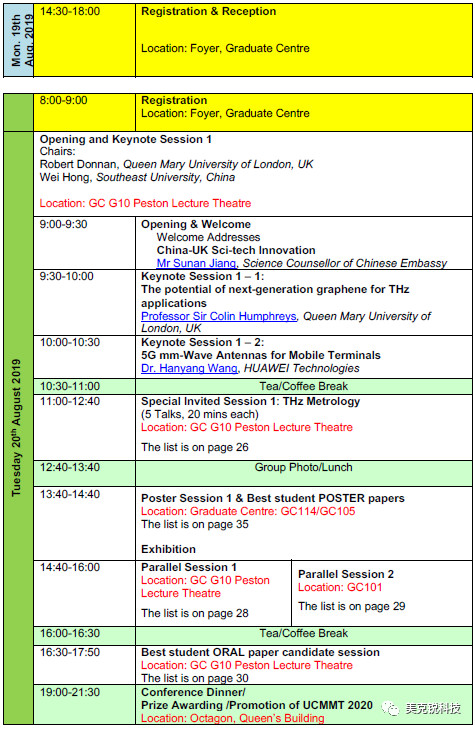
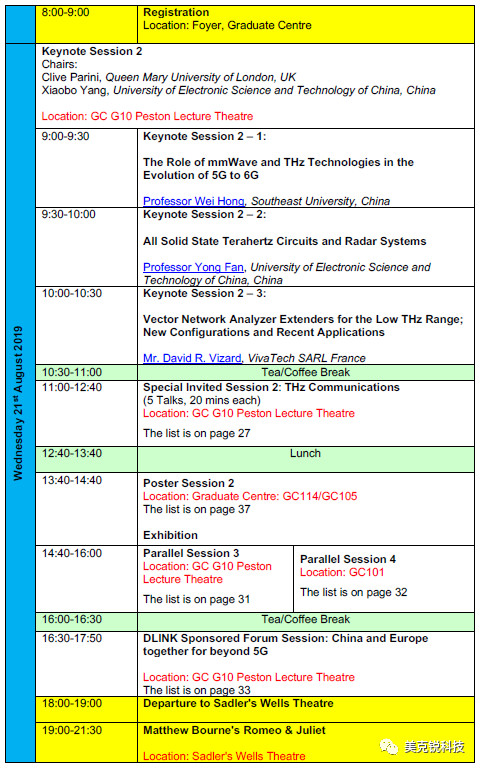
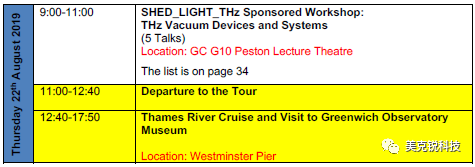
Special Invited Sessions 1: THz Metrology (Tuesday)
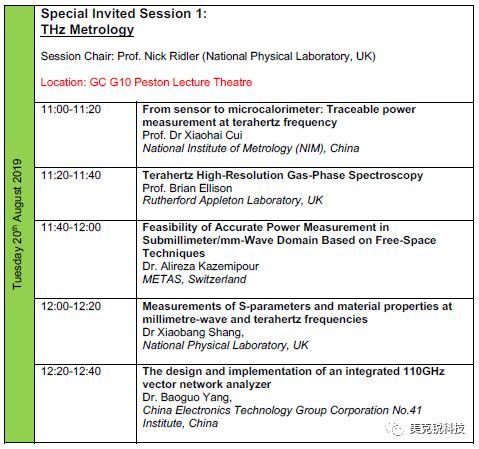
Special Invited Sessions 2: THz Communications (Wednesday)
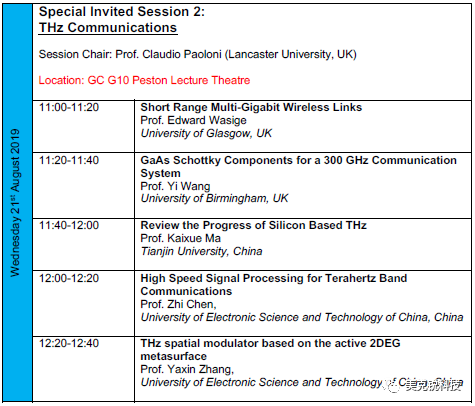
Parallel Sessions 1 (Tuesday)

Parallel Sessions 2 (Tuesday)
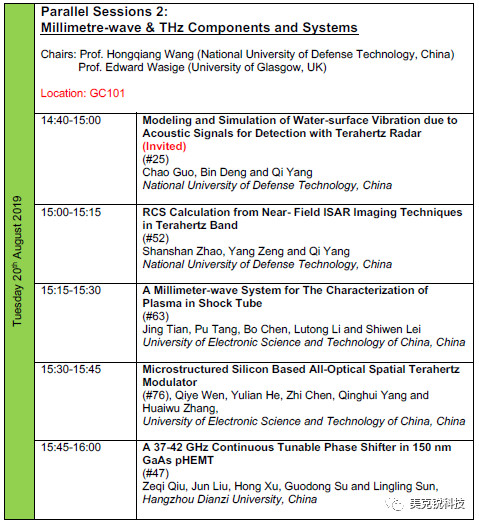
Best Student Oral Paper Candidate Session (Tuesday)
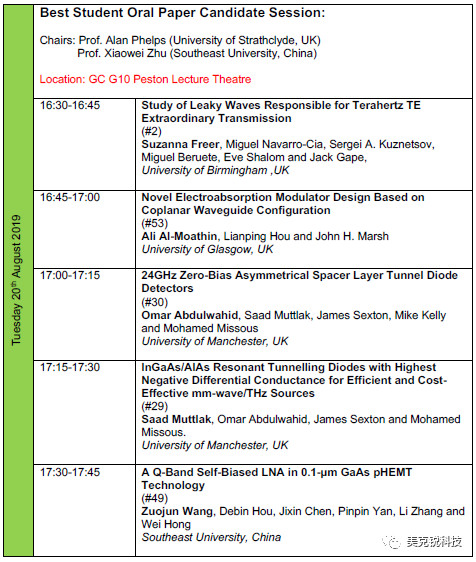
Parallel Sessions 3 (Wednesday)
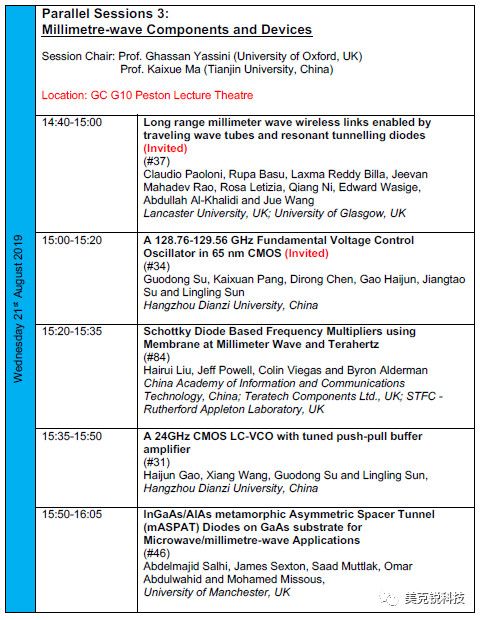
Parallel Sessions 4 (Wednesday)
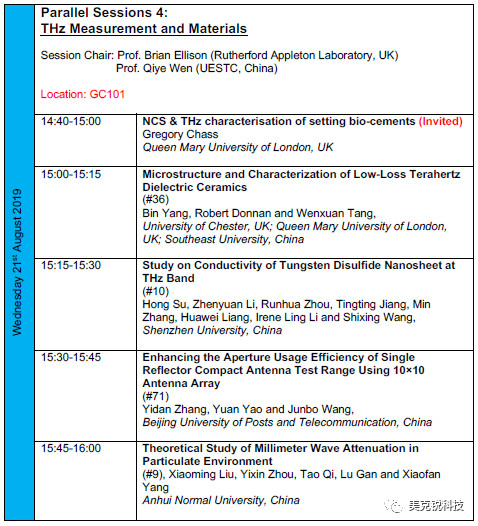
DLINK Sponsored Forum Session: China and Europe together for
beyond 5G (Wednesday)
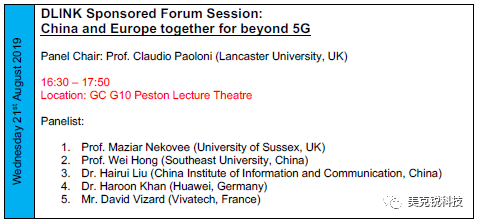
SHED_LIGHT_THz Sponsored Workshop: THz Vacuum Devices and
Systems (Thursday)
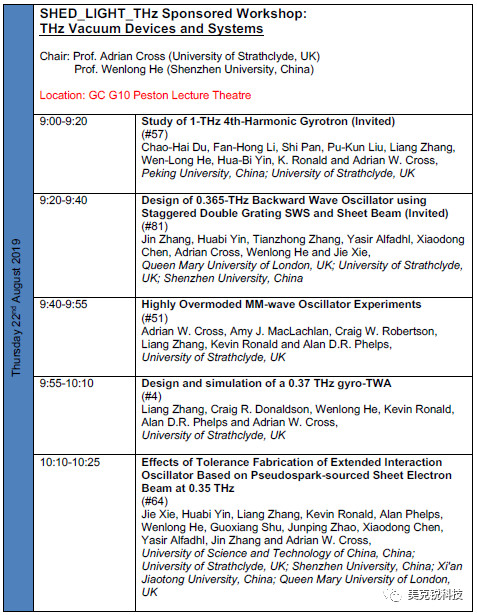
Interactive Poster Session 1: Tuesday
Tuesday 13:40-14:40 20th August 2019,
Location: Graduate Centre: GC114 and GC105
Chairs:
Prof. Giorgio Savini, University College of London, UK
Prof. Xiaoming Liu, Anhui Normal University, China
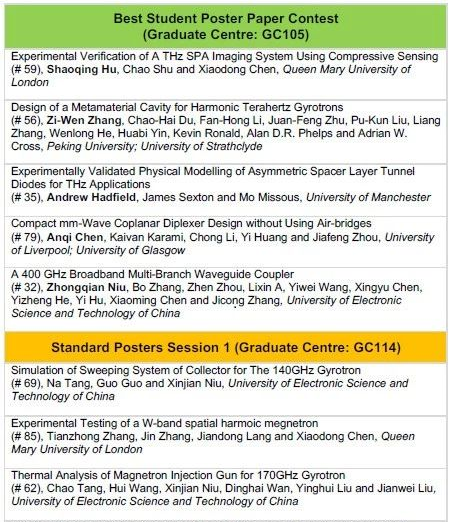
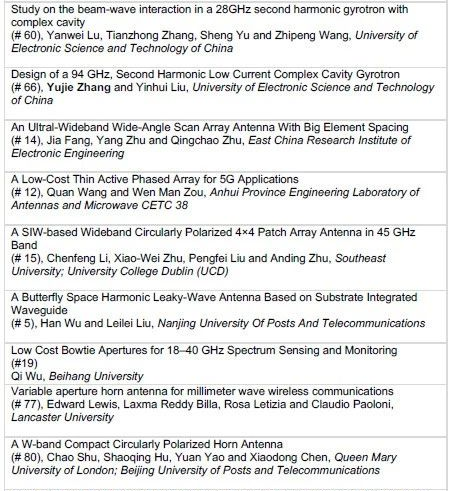
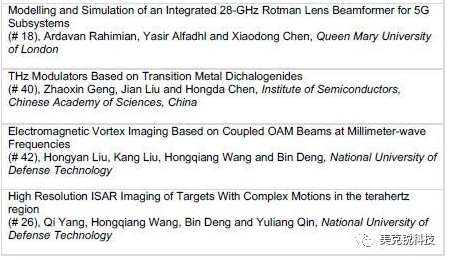
Interactive Poster Session 2: Wednesday
Wednesday 13:40-14:40 21st August 2019,
Location: Graduate Centre: GC114 and GC105
Chairs:
Prof. Yuan Yao, Beijing University of Posts and Telecommunications, China
Dr. Jiafeng Zhou, University of Liverpool, UK
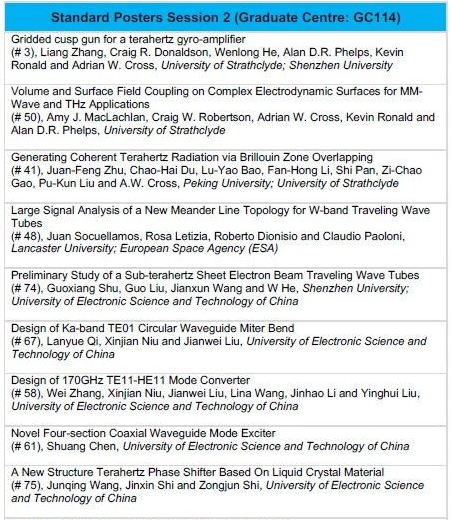
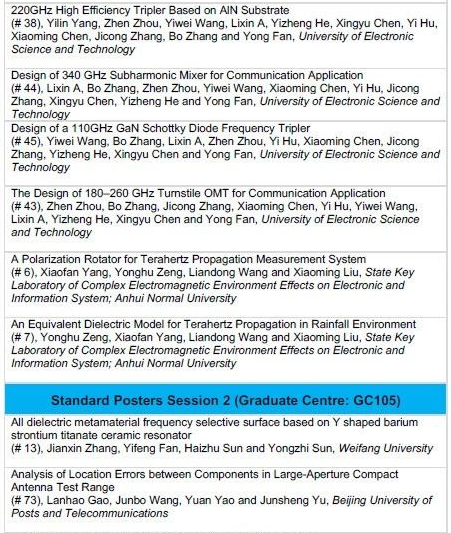
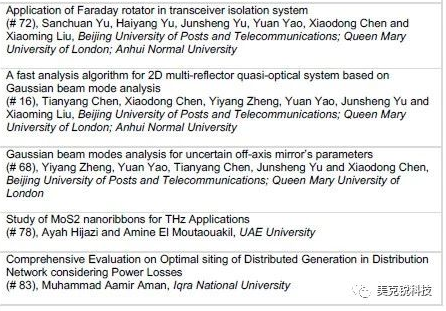
Instruction for Presenters and Chairs
Instruction on Sessions Venues
The workshop will take place at Graduate Centre of Queen Mary University of London, which locates at right hand of side entrance on the Bancroft Road, opposite to the G.E.Fogg Building. It is denoted as number 18 in the following website and the photo of building is shown below too.
https://ph.qmul.ac.uk/sites/default/files/Article/Mile-End-campus-map.pdf
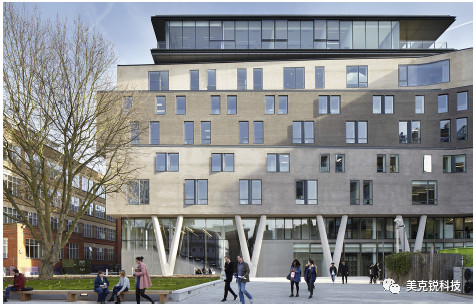
All sessions are mainly held in GC G10 Peston Lecture Theatre (Ground Floor) and GC 101/114/105 (First Floor).
GC G10 Peston Lecture Theatre: Opening session/2 Keynote sessions/2 Special invited sessions/Student oral session/Forum Session/Vacuum Electronics
Workshop AND parallel session 1/3
GC101: Parallel sessions 2/4
GC114: & GC105: All poster sessions
Instruction for Presenters in Oral Sessions
The duration of a keynote presentation is 30 minutes. This includes 25 minutes for the presentation and 5 minutes for questions and answers.
The duration of an invited talk is 20 minutes (single session) and 15 minutes (parallel sessions), which includes the time for presentation and questions and answers. We appreciate it if all presenters can adhere strictly to this time limit.
Presentation slides must be prepared using Microsoft PowerPoint or Adobe Acrobat.
Speakers should copy their files to a USB stick and upload their files at least 10 minutes before the commencement of each session as well as report to their respective Session Chairs. A standard LCD projector which is connected to a local computer (Win10, Office 2016) will be provided in each conference room.
All papers must be presented in person at the conference in order to be included in the proceedings published in IEEE Xplore.
Instructions for Presenters in Poster Sessions
Posters will be mounted on the specific board using pin or glue that will be provided.
The size of the poster should be A0 (1189 mm×841 mm). It is advisable that your poster be readable from 1.5 to 2 meters away.
Please set up your poster in the allocated position (the number on the location is the ID number of your paper), at the beginning of the morning coffee break. Presenters are requested to stay next to their posters during the Interactive Session. Posters must be removed by the speaker at the end of the afternoon. All papers must be presented in person at the conference in order to be included in the proceedings published in IEEE Xplore.
Instructions for Presenters in Best Student Paper Contest
The Best Student Paper Award will be decided by a panel of world leading experts, based on the quality of (1) the submitted full paper (2) the 15-minutes oral presentation and (3) or the poster presentation. The student must attend either the oral or poster presentation sessions.
For the student paper contest in oral presentation session, each student must upload his/her presentation file at least 10 minutes before the commencement of the Best Student Paper Contest session which will take place on Tuesday 20 August afternoon.
Instructions for Oral Session Chairs
Please introduce speakers very briefly in the beginning of each presentation.
Due to the limited time allocated to each speaker, we must be strict on keeping the schedule. Please remind the speak to complete the presentation at least 3 minutes before the end of his/her allocated time (30 minutes, 20 minutes and 15 minutes for keynotes, single session and parallel session invited talks, respectively). It should be followed byquestions and answers. It is a good idea to inform your presenters at the start of the session how you intend to reminder the speaker when time is due to finish.
Instructions for Poster Session Chairs
The standard of these papers is expected to be high and some very high-quality papers should be selected for the IET special issue we have planned for. It is the Chairs’responsibility to recommend about 5 papers/session to the TPC Chairs.
Also, to meet the IEEE Xplore requirements, each paper must be properly presented by one of the authors at the Workshop. It is the Chairs’ responsibility to record and report any missing papers.
Social Programmes
During 14:30-18:00, 19th, August, the welcome reception will take place at Foyer, Graduate Centre, Queen Mary University of London. This is a great opportunity for attendees to share their experience and joy. All delegates are welcome to join, and drinks and snacks will be provided on site.
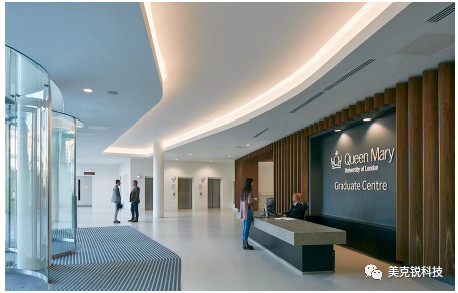
The conference banquet will take place at 19:00-21:30, 20th, August at Octagon, Queen’s Building, Queen Mary University of London. All delegates are invited to the banquet with fees included in the registration (additional tickets could be purchased for guests).
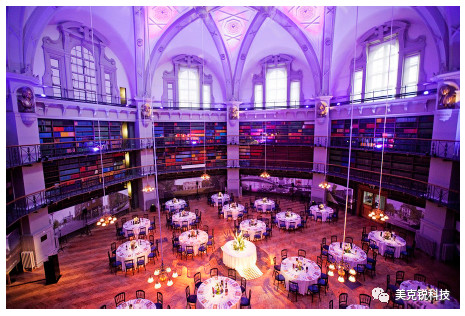
On 21st August, there will be a play of Matthew Bourne's Romeo & Juliet at Sadler's Wells Theatre. Coaches will be provided for the departure and return. The departure time is 18:10 and the return time is 21:45, please arrive earlier since the coaches cannot not wait and be aware of further notice about any changes of time and assembling place.
Matthew Bourne’s Romeo and Juliet is a passionate and contemporary re-imagining of Shakespeare’s classic love story. Confined against their will by a society that seeks to divide, our two young lovers must follow their hearts as they risk everything to be together. Bursting with youth, vitality and Matthew Bourne’s trademark storytelling,London’s brightest young dance talent join the New Adventures company, with direction and choreography by Matthew Bourne, design by Lez Brotherston, lighting by Paule Constable, sound by Paul Groothuis and new orchestrations of the Sergei Prokofiev score by Terry Davies,played live by the New Adventures Orchestra.

On 22nd, August, there will be a social tour including Thames River Cruise and visit to Greenwich Observatory Museum. The hired coach will depart at 11:00. Please be aware of further notice about any changes of time and assembling place.
Westminster to Greenwich River Thames Sightseeing Cruise (Duration: 1-2 Hrs)
• Take the scenic route from Westminster to Greenwich with the River Thames cruise.
• See the iconic monuments of London from a unique perspective on the waters, such as the Houses of Parliament, Westminster Palace, The Shard and much more.
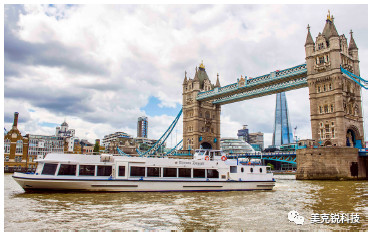
The Royal Observatory, Greenwich (ROG, known as the Old Royal
Observatory from 1957 to 1998, when the working Royal Greenwich
Observatory, RGO, moved from Greenwich to Herstmonceux) is an observatory situated on a hill in Greenwich Park, overlooking the River Thames. Itplayed a major role in the history of astronomy and navigation, and is best known for the fact that the prime meridian passes through it, and thereby gave its name to Greenwich Mean Time.

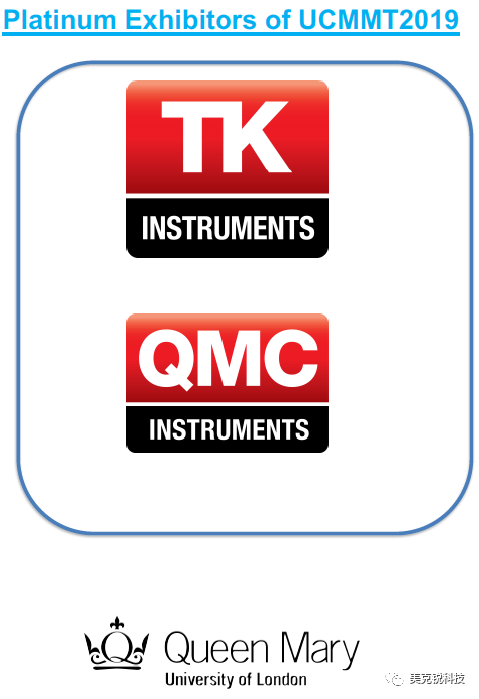
版权所有:北京市石景山区 毫米波太赫兹产业发展联盟 京ICP备19046674号-1联系地址:北京市石景山区盛景国际广场A座中欧科技创新中心1701室 联系电话:86-10-68884110